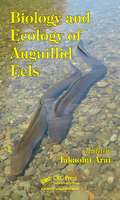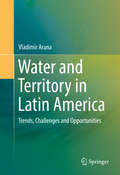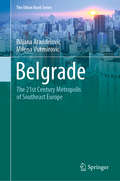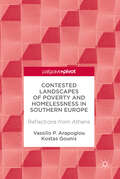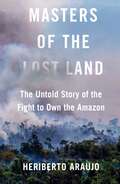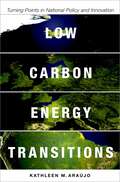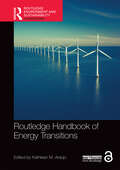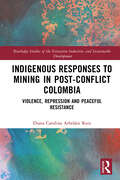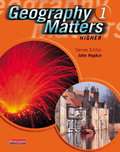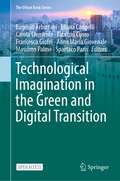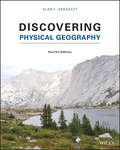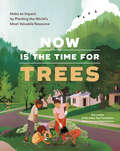- Table View
- List View
Biology and Ecology of Anguillid Eels
by Takaomi AraiAnguillid eels have fascinated biologists for centuries due to their spectacular long-distance migrations between freshwater habitats and their spawning areas far out in the ocean. This book provides a long overdue update on the biology and ecology of anguillid eels and features comprehensive coverage of the key features of the genus Anguilla. It c
Advances in Groundwater Pollution Control and Remediation (NATO Science Partnership Subseries: 2 #9)
by Mustafa Aral AralIn the past decades, environmental scientists, economists and physicists have been juggling critical issues within environmental strategies and environmental management styles in order to find a feasible medium between limited resources, long term demands and objectives, and interest groups. In the search for best management alternatives, practice has undergone a pendulum swing between stages that can be characterised as frontier economics, radical environmentalism, resource management/allocation, selective environmentalism and sustainable environmental management. The next stage of management must answer such questions as: `Can there be a global - uniform environmental strategy?', or `Based on their characteristics, can different issues, different regions and different applications have unique environmental strategies?' Based on this premise, the next stage of management may be identified as risk based sustainable environmental management. The goal of this style will be the risk based, long term, harmonious management of economic resources and environmental preservation for health, safety and prosperity of sustainable populations. When evaluation of risk or risk based ranking of management alternatives enter the picture as part of the overall puzzle, then social policy, ethics and health issues assume a very important role in the management strategy. Economic incentives and environmental constraints have to be considered harmoniously, the main emphasis being placed on protection and preservation of human health and the long term sustaining of populations.
Water and Territory in Latin America: Trends, Challenges and Opportunities
by Vladimir AranaThis book focuses in the current situation of water resources, water supply and sanitation, and population movement in Latin America. It identifies new phenomena and challenges that will put more pressure on water resources in the near future and that will create important socioeconomic constraints in population and their governments. This volume offers an evaluation of water resources availability and consumption, water supply and sanitation shortages, management models and population growth and territory occupation trends in eighteen Latin American countries. Also a set of recommendations, policy proposals and projects is outlined.
Denise Scott Brown (Springer Biographies)
by Biljana ArandelovicDenise Scott Brown is best known as part of one of the most acclaimed architectural partnerships in modern architectural history, Denise Scott Brown & Robert Venturi. Together with Venturi, she ran the firm Venturi, Scott Brown & Associates (VSBA). Their architectural and urban planning designs, theories and publications caused a revolution in the world of architecture. Their most famous theoretical work, co-authored with Steven Izenour, Learning from Las Vegas, became a global phenomenon that marked the 20th century. Scott Brown & Venturi were also a married couple. However, in the traditional male-dominated architectural world, men were automatically put in leadership positions while the role of women was always underplayed, although they worked in equal partnership and made the same contribution. The role of Denise Scott Brown in joint projects, in the eyes of the public, was for decades diminished, while Venturi was brought to the forefront and celebrated as a genius. She never received due recognition for her work.This book is entirely dedicated to Denise Scott Brown and gives her the credit she deserves. It informs readers about her life, analyzes her projects in both architecture and urban planning, and offers a better understanding of her theories. The seven chapters provide a comprehensive insight into the world of legendary Denise and complete the knowledge necessary to understand her as a true and authentic diva of architecture, an innovative urban planner, theorist and passionate professor. Chapter 8 is a comprehensive conclusion that rounds off the monograph through a shorter review of numerous topics covered in the previous chapters. At the very beginning of the book is a letter that Denise wrote to the author. Her words are an authentic testimony of her life after 1967. The book is richly illustrated with a total of 274 photographs, urban planning layouts and various project illustrations.
Belgrade: The 21st Century Metropolis of Southeast Europe (The Urban Book Series)
by Biljana Arandelovic Milena VukmirovicThis book highlights Belgrade, reviewing its recent and historical developments and emphasizing its major ongoing planning projects. The book is divided into eight chapters. The first, entitled The urban, political and socioeconomic rise and fall of Belgrade through its history, introduces the reader to the city, and is followed by a chapter on Belgrade’s urban plans through history. The book continues with a chapter on one of the major urban projects in the former Yugoslavia, the construction of New Belgrade, its development and results, entitled New Belgrade: from no man’s land to modern city. In turn, the following three chapters explore three dominant contemporary topics: Belgrade’s riverfront redevelopment; Reimaging Belgrade: the case of Savamala; and Sustainable Belgrade. Expansion of the pedestrian zone in the city center. The book draws to a close with a chapter on Future predictions: South-Eastern European metropolis of the 21st century. This chapter in particular discusses large city projects and includes predictions about the city’s future.
Physical Models of Cell Motility (Biological and Medical Physics, Biomedical Engineering)
by Igor S. AransonThis book surveys the most recent advances in physics-inspired cell movement models. This synergetic, cross-disciplinary effort to increase the fidelity of computational algorithms will lead to a better understanding of the complex biomechanics of cell movement, and stimulate progress in research on related active matter systems, from suspensions of bacteria and synthetic swimmers to cell tissues and cytoskeleton.Cell motility and collective motion are among the most important themes in biology and statistical physics of out-of-equilibrium systems, and crucial for morphogenesis, wound healing, and immune response in eukaryotic organisms. It is also relevant for the development of effective treatment strategies for diseases such as cancer, and for the design of bioactive surfaces for cell sorting and manipulation. Substrate-based cell motility is, however, a very complex process as regulatory pathways and physical force generation mechanisms are intertwined. To understand the interplay between adhesion, force generation and motility, an abundance of computational models have been proposed in recent years, from finite element to immerse interface methods and phase field approaches.This book is primarily written for physicists, mathematical biologists and biomedical engineers working in this rapidly expanding field, and can serve as supplementary reading for advanced graduate courses in biophysics and mathematical biology. The e-book incorporates experimental and computer animations illustrating various aspects of cell movement.
Contested Landscapes of Poverty and Homelessness In Southern Europe: Reflections from Athens
by Vassilis P. Arapoglou Kostas GounisThe book uses Athens as a case study to identify the key features of urban anti-poverty policies in Greece and to discuss them in relation to policy developments in the crisis-ridden countries of Southern Europe. The idea of contested landscapes shapes the focus of the book on urban poverty and homelessness. Contested landscapes refer to the complex dynamics between visible and invisible poverty and to competing strategies on how to address them. The book takes a path-dependent view on the development of post-welfare arrangements, devolution, and pluralism that are being shaped by both neoliberal mentality, solidarity and communitarian practices. The authors draw on their own research and advocacy background in New York and Athens to shape their conceptual and methodological tools; however, rather than uncritically ‘importing’ North American and North European concepts to Greece, the book highlights the significance of distinctive Mediterranean features for analysing homelessness and anti-poverty policies. This will be a useful read for academics policy makers in areas of urban studies, sociology, social policy, human geography and anthropology.
Morphological Regionalization: Strengthening the Conzenian Method (The Urban Book Series)
by Muzaffer Ali AratThis book is about how to make the method of morphological regionalization, proposed in the early 1960s, more useful and practicable for planning, urban design and architecture. This book is about cities; more precisely, about how cities can be characterized based on the main elements of urban form. It provides a systematic way of description and explanation of the historico-geographical structure of the urban landscape. It offers a step-by-step methodology for the identification of morphological regions as a key tool for planning practice and townscape management. The book is divided in seven parts. The first part is the introduction, motivation, research goal and objectives, and the structure of the book. The second part of the book offers an overview of urban morphology, urban morphological approaches, the concept of morphological region and its past applications worldwide. The third part is the methodological procedures for the implementation of this morphological approach to cities. The fourth and fifth parts are the implementation of this methodology into two case studies, Istanbul and Antequera. The sixth part offers a discussion of results. And, finally, the seventh part is constituted by a set of conclusions.
Integrable Hierarchies and Modern Physical Theories (NATO Science Series II: Mathematics, Physics and Chemistry #18)
by Henrik Aratyn Alexander S. SorinProceedings of the NATO Advanced Research Workshop, Chicago, USA, July 22-26, 2000
Urban Morphology: An Introduction to the Study of the Physical Form of Cities (The Urban Book Series)
by Vítor Manuel Araújo de Oliveira'This is a textbook about cities or, more precisely, about the physical form of cities. It provides an overview of the main elements of urban form—streets, street blocks, plots and buildings—structuring our cities and the fundamental agents and processes of transformation shaping these elements. It applies this analytical framework to describe the evolution of cities over history as well as to explain the functioning of contemporary cities. After the initial focus on the 'object' (cities), the book introduces how different schools of thought have been dealing with this object since the emergence of Urban Morphology, as the science of urban form, in the turning to the twentieth century. Finally, the book identifies the main contributions of urban morphology to cities, societies and economies. This second edition of the book offers updated and more accurate knowledge on several morphological issues, presents expanded contents, and it has a more explicit didactic nature, including a set of exercises in the end of each chapter, that will help teachers and students (in architecture, geography, planning, history, sociology and urban studies) in acquiring and consolidating their urban morphological knowledge.
Masters of the Lost Land: The Untold Story of the Fight to Own the Amazon
by Heriberto Araujo'Excellent' Kirkus Reviews'[A] deeply researched report from the front lines of the battle for the Amazon.' Publishers Weekly'A gripping true crime mystery... a must-read' Greg Grandin, Pulitzer Prize-winning author of The End of the Myth'An essential book' Joe Jackson, author of The Thief at the End of the WorldDeep in the heart of the Amazon, an entire region has lived under the control of one notorious land baron: Josélio de Barros. Josélio cut a grisly path to success: having arrived in the jungle with a shady past, he quickly made a name for himself as an invincible thug who grabbed massive tracts of public land, burned down the jungle and executed or enslaved anyone trying to stop him.Enter Dezinho, the leader of a small but robust farm workers' union fighting against land grabs, ecological destruction, and blatant human rights abuses. When Dezinho was killed in a shocking assassination, the local community held its breath. Would Josélio, whom everyone knew had ordered the hit, finally be brought to account? Or would authorities look the other way, as they had hundreds of times before?Dezinho's widow, Dona Joelma, was not about to let that happen. After his murder, she stepped into the spotlight, orchestrating a huge push to bring national media attention to the injustices in the Amazon.Set against the backdrop of Bolsonaro's devastating cuts to environmental protections, Brazil's rapidly changing place in the geopolitical spectrum, and the Amazon's crucial role in climate change, Masters of the Lost Land is both a gripping epic into one of the last wild places on Earth and an urgent illustration of how people are fighting for - and winning - justice for their futures and the environment.
Low Carbon Energy Transitions: Turning Points in National Policy and Innovation
by Kathleen AraújoThe world is at a pivotal crossroad in energy choices. There is a strong sense that our use of energy must be more sustainable. Moreover, many also broadly agree that a way must be found to rely increasingly on lower carbon energy sources. However, no single or clear solution exists on the means to carry out such a shift at either a national or international level. Traditional energy planning (when done) has revolved around limited cost projections that often fail to take longer term evidence and interactions of a wider set of factors into account. The good news is that evidence does exist on such change in case studies of different nations shifting toward low-carbon energy approaches. In fact, such shifts can occur quite quickly at times, alongside industrial and societal advance, innovation, and policy learning. These types of insights will be important for informing energy debates and decision-making going forward. Low Carbon Energy Transitions: Turning Points in National Policy and Innovation takes an in-depth look at four energy transitions that have occurred since the global oil crisis of 1973: Brazilian biofuels, Danish wind power, French nuclear power, and Icelandic geothermal energy. With these cases, Dr. Araújo argues that significant nationwide shifts to low-carbon energy can occur in under fifteen years, and that technological complexity is not necessarily a major impediment to such shifts. Dr. Araújo draws on more than five years of research, and interviews with over 120 different scientists, government workers, academics, and members of civil society in completing this study. Low Carbon Energy Transitions is written for for professionals in energy, the environment and policy as well as for students and citizens who are interested in critical decisions about energy sustainability. Technology briefings are provided for each of the major technologies in this book, so that scientific and non-scientific readers can engage in more even discussions about the choices that are involved.
Low Carbon Energy Transitions: Turning Points in National Policy and Innovation
by Kathleen AraújoThe world is at a pivotal crossroad in energy choices. There is a strong sense that our use of energy must be more sustainable. Moreover, many also broadly agree that a way must be found to rely increasingly on lower carbon energy sources. However, no single or clear solution exists on the means to carry out such a shift at either a national or international level. Traditional energy planning (when done) has revolved around limited cost projections that often fail to take longer term evidence and interactions of a wider set of factors into account. The good news is that evidence does exist on such change in case studies of different nations shifting toward low-carbon energy approaches. In fact, such shifts can occur quite quickly at times, alongside industrial and societal advance, innovation, and policy learning. These types of insights will be important for informing energy debates and decision-making going forward. Low Carbon Energy Transitions: Turning Points in National Policy and Innovation takes an in-depth look at four energy transitions that have occurred since the global oil crisis of 1973: Brazilian biofuels, Danish wind power, French nuclear power, and Icelandic geothermal energy. With these cases, Dr. Araújo argues that significant nationwide shifts to low-carbon energy can occur in under fifteen years, and that technological complexity is not necessarily a major impediment to such shifts. Dr. Araújo draws on more than five years of research, and interviews with over 120 different scientists, government workers, academics, and members of civil society in completing this study. Low Carbon Energy Transitions is written for for professionals in energy, the environment and policy as well as for students and citizens who are interested in critical decisions about energy sustainability. Technology briefings are provided for each of the major technologies in this book, so that scientific and non-scientific readers can engage in more even discussions about the choices that are involved.
Routledge Handbook of Energy Transitions (Routledge Environment and Sustainability Handbooks)
by Kathleen AraújoThe Routledge Handbook of Energy Transitions draws upon a unique and multidisciplinary network of experts from around the world to explore the expanding field of energy transitions.This Handbook recognizes that considerable changes are underway or are being developed for the modes in which energy is sourced, delivered, and utilized. Employing a sociotechnical approach that accounts for economics and engineering, as well as more cross-cutting factors, including innovation, policy and planning, and management, the volume considers contemporary ideas and practices that characterize the field. The book explores pressing issues, including choices about infrastructure, the role of food systems and materials, sustainability, and energy democracy. Disruption is a core theme throughout, with the authors examining topics such as digitalization, extreme weather, and COVID-19, along with regional similarities and differences. Overall, the Routledge Handbook of Energy Transitions advances the field of energy transitions by connecting ideas, taking stock of empirical insights, and challenging how we think about the theory and practice of energy systems change.This innovative volume functions as an authoritative roadmap with both regional and global relevance. It will be an essential resource for students, policymakers, researchers, and practitioners researching and working in the fields of energy transitions, planning, environmental management and policy, sustainable business, engineering, science and technology studies, political science, geography, design anthropology, and environmental justice.“With the exception of Chapter 26, no part of this book may be reprinted or reproduced or utilised in any form or by any electronic, mechanical, or other means, now known or hereafter invented, including photocopying and recording, or in any information storage or retrieval system, without permission in writing from the publishers.” Chapter 26 of this book is freely available as a downloadable Open Access PDF at http://www.taylorfrancis.com under a Creative Commons [Attribution-Non Commercial-No Derivatives (CC-BY-NC-ND)] 4.0 license.
Routledge Handbook of Energy Transitions (Routledge Environment and Sustainability Handbooks)
by Kathleen M. AraújoThe Routledge Handbook of Energy Transitions draws upon a unique and multidisciplinary network of experts from around the world to explore the expanding field of energy transitions.This Handbook recognizes that considerable changes are underway or are being developed for the modes in which energy is sourced, delivered, and utilized. Employing a sociotechnical approach that accounts for economics and engineering, as well as more cross-cutting factors, including innovation, policy and planning, and management, the volume considers contemporary ideas and practices that characterize the field. The book explores pressing issues, including choices about infrastructure, the role of food systems and materials, sustainability, and energy democracy. Disruption is a core theme throughout, with the authors examining topics such as digitalization, extreme weather, and COVID-19, along with regional similarities and differences. Overall, the Routledge Handbook of Energy Transitions advances the field of energy transitions by connecting ideas, taking stock of empirical insights, and challenging how we think about the theory and practice of energy systems change.This innovative volume functions as an authoritative roadmap with both regional and global relevance. It will be an essential resource for students, policymakers, researchers, and practitioners researching and working in the fields of energy transitions, planning, environmental management and policy, sustainable business, engineering, science and technology studies, political science, geography, design anthropology, and environmental justice.“With the exception of Chapter 26, no part of this book may be reprinted or reproduced or utilised in any form or by any electronic, mechanical, or other means, now known or hereafter invented, including photocopying and recording, or in any information storage or retrieval system, without permission in writing from the publishers.” Chapter 26 of this book is freely available as a downloadable Open Access PDF at http://www.taylorfrancis.com under a Creative Commons [Attribution-Non Commercial-No Derivatives (CC-BY-NC-ND)] 4.0 license.
Three-Dimensional Flows (Ergebnisse der Mathematik und ihrer Grenzgebiete. 3. Folge / A Series of Modern Surveys in Mathematics #53)
by Vítor Araújo Maria José PacificoIn this book, the authors present the elements of a general theory for flows on three-dimensional compact boundaryless manifolds, encompassing flows with equilibria accumulated by regular orbits. The book aims to provide a global perspective of this theory and make it easier for the reader to digest the growing literature on this subject. This is not the first book on the subject of dynamical systems, but there are distinct aspects which together make this book unique. Firstly, this book treats mostly continuous time dynamical systems, instead of its discrete counterpart, exhaustively treated in some other texts. Secondly, this book treats all the subjects from a mathematical perspective with proofs of most of the results included. Thirdly, this book is meant to be an advanced graduate textbook and not just a reference book or monograph on the subject. This aspect is reflected in the way the cover material is presented, with careful and complete proofs, and precise references to topics in the book.
Geometry of Algebraic Curves: Volume II with a contribution by Joseph Daniel Harris (Grundlehren der mathematischen Wissenschaften #268)
by Enrico Arbarello Maurizio Cornalba Phillip GriffithsThe second volume of the Geometry of Algebraic Curves is devoted to the foundations of the theory of moduli of algebraic curves. Its authors are research mathematicians who have actively participated in the development of the Geometry of Algebraic Curves. The subject is an extremely fertile and active one, both within the mathematical community and at the interface with the theoretical physics community. The approach is unique in its blending of algebro-geometric, complex analytic and topological/combinatorial methods. It treats important topics such as Teichmüller theory, the cellular decomposition of moduli and its consequences and the Witten conjecture. The careful and comprehensive presentation of the material is of value to students who wish to learn the subject and to experts as a reference source. The first volume appeared 1985 as vol. 267 of the same series.
Indigenous Responses to Mining in Post-Conflict Colombia: Violence, Repression and Peaceful Resistance (Routledge Studies of the Extractive Industries and Sustainable Development)
by Diana Carolina Arbeláez RuizThis book examines Indigenous responses to mining and their connection to peacebuilding, focusing on the experience of the Nasa Indigenous people of North Cauca during the most recent Colombian post-agreement transition. Amid an armed conflict that has disproportionally affected and targeted the Nasa, as well as ongoing processes of dispossession and oppression, the Nasa have built a tradition of organised, peaceful resistance. This book examines the nature of their responses to mining and how this is linked to peacebuilding, with a focus on how resistance is shaped and enacted to respond to the relationship mineral extraction has with violence and peace. The work is exploratory, ethnographic and interdisciplinary in nature, sitting in the intersection between the anthropology of mining, development studies and peace and conflict studies. The author presents and analyses narratives, participant responses, and her own experiences to illustrate the context and interconnected processes shaping Nasa responses to mining during this transition period. The book will bring international readers closer to these intricate dynamics, where access is otherwise limited because of security, cultural, linguistic and other barriers. The book provides a novel perspective on post-conflict mining governance by focusing on the Nasa’s active role in responding to mining in a post-agreement, transitional context. It highlights, and encourages engagement with, the often-overlooked role of morality in debates about nature and development. This book will be of great interest to students, scholars and practitioners of the extractive industries, natural resource management, conflict management and peacebuilding, Indigenous Peoples and Latin American studies.
Indigenous Responses to Mining in Post-Conflict Colombia: Violence, Repression and Peaceful Resistance (Routledge Studies of the Extractive Industries and Sustainable Development)
by Diana Carolina Arbeláez RuizThis book examines Indigenous responses to mining and their connection to peacebuilding, focusing on the experience of the Nasa Indigenous people of North Cauca during the most recent Colombian post-agreement transition. Amid an armed conflict that has disproportionally affected and targeted the Nasa, as well as ongoing processes of dispossession and oppression, the Nasa have built a tradition of organised, peaceful resistance. This book examines the nature of their responses to mining and how this is linked to peacebuilding, with a focus on how resistance is shaped and enacted to respond to the relationship mineral extraction has with violence and peace. The work is exploratory, ethnographic and interdisciplinary in nature, sitting in the intersection between the anthropology of mining, development studies and peace and conflict studies. The author presents and analyses narratives, participant responses, and her own experiences to illustrate the context and interconnected processes shaping Nasa responses to mining during this transition period. The book will bring international readers closer to these intricate dynamics, where access is otherwise limited because of security, cultural, linguistic and other barriers. The book provides a novel perspective on post-conflict mining governance by focusing on the Nasa’s active role in responding to mining in a post-agreement, transitional context. It highlights, and encourages engagement with, the often-overlooked role of morality in debates about nature and development. This book will be of great interest to students, scholars and practitioners of the extractive industries, natural resource management, conflict management and peacebuilding, Indigenous Peoples and Latin American studies.
Geography Matters 1: Higher (PDF)
by Nicola Arber Linda Thompson Sue Lomas Garrett Nagle Paul ThompsonGeography Matters is a Key Stage 3 course created for pupils of all abilities. It provides an exact match to the requirement of the revised National Curriculum, and to the units of the Key Stage 3 Scheme of Work. Contents include: Making connections Restless Earth People everywhere Flood disaster Exploring England World sport
Spatial Econometrics: Statistical Foundations and Applications to Regional Convergence (Advances in Spatial Science)
by Giuseppe ArbiaThis book bridges the gap between economic theory and spatial econometric techniques. It is accessible to those with only a basic statistical background and no prior knowledge of spatial econometric methods. It provides a comprehensive treatment of the topic, motivating the reader with examples and analysis. The volume provides a rigorous treatment of the basic spatial linear model, and it discusses the violations of the classical regression assumptions that occur when dealing with spatial data.
Technological Imagination in the Green and Digital Transition (The Urban Book Series)
by Eugenio Arbizzani Eliana Cangelli Carola Clemente Fabrizio Cumo Francesca Giofrè Anna Maria Giovenale Massimo Palme Spartaco ParisThis open access book addresses the pressing need for sustainability in urban development and the use of technology, with cities to serve as the main stage for strategies that seek to meet the targets and the cross-sector priorities indicated in the EU’s Next Generation program, all in pursuit of a solid recovery on the part of the European economy, along lines of ecological transition, digitalization, competitiveness, training, and inclusion to overcome social, territorial, and gender differences.The international study encounter is meant to promote visions shared by architectural technology and other disciplines, which, though they may appear to differ, are closely interconnected, with the aim of achieving an open, interdisciplinary integration capable of proposing concrete projects regarding topics held to be of strategic importance to the future of the built environment. These are identified to draw up evolving scenarios of architecture and cities suited to reflection, at various levels, on innovative models of process and product.
Discovering Physical Geography
by Alan F. ArbogastWith Wiley’s Enhanced E-Text, you get all the benefits of a downloadable, reflowable eBook with added resources to make your study time more effective, including: • Visual Concept Checks• Imbedded Glossary with clickable references & key words• Show & Hide Solutions with automatic feedbackArbogast’s Discovering Physical Geography, 4th Edition provides interactive questions that help readers comprehend important Earth processes. The Fourth Edition continues to place great emphasis on how relevant physical geography is to each reader’s life. With an enhanced focus on the interconnections between humans and their environment, this text includes increased coverage of population growth and its impact on the environment. Updated case studies are included, as well as new sections dealing with human interactions with solar energy, wind power, soils, and petroleum. This text is welcoming, taking readers on a tour of “discovery”, and delivers content that is sound and based on the most current scientific research.
Now Is the Time for Trees: Make an Impact by Planting the Earth's Most Valuable Resource
by Arbor Day Foundation Dan Lambe&“Celebrates the power of trees to oxygenate the planet, purify water and air, lower city temperatures, provide habitat, nurture the soul, and provide essential food sources.&” —Booklist Trees and forests are the number one nature-based solution for reversing the negative effects of a changing climate. If ever there was a time to be planting trees, that time is now. Inspired by a collective sense of urgency, a global movement to plant trees is gaining momentum. To move the needle, we need to act on a massive scale and plant millions of trees today to have a measurable and lasting impact on billions of lives tomorrow. In Now Is the Time for Trees, the experts at the Arbor Day Foundation will inspire you to do your part by showing you everything you need to know to plant trees at home or in your community. From advice on choosing the right size and type of tree to tried-and-true tips for planting success, this book will help you plant a tree today and leave your own legacy of hope. Equal parts inspiration and advocacy, Now Is the Time for Trees is a rousing call for environmental action and a must-have book for nature lovers everywhere.
Multidimensional Minimizing Splines: Theory and Applications
by R. Arcangéli María Cruz López de Silanes Juan José TorrensThis book is of interest to mathematicians, geologists, engineers and, in general, researchers and post graduate students involved in spline function theory, surface fitting problems or variational methods. From reviews: The book is well organized, and the English is very good. I recommend the book to researchers in approximation theory, and to anyone interested in bivariate data fitting." (L.L. Schumaker, Mathematical Reviews, 2005).
